Cheese is a beloved dairy product enjoyed across cultures, with each variety offering unique textures, flavours, and culinary applications. From creamy and mild fresh cheeses to rich and tangy blue cheeses, the diversity of cheese, rooted in the fascinating process of cheesemaking, makes it a staple in countless dishes.
Whether you’re looking for the perfect cheese to melt into a dish, sprinkle over pasta, or serve on a cheese board, this guide explores 31 different types of cheese from around the world and their best uses.
“Get a quick overview of some types of cheese before driving into the main content.
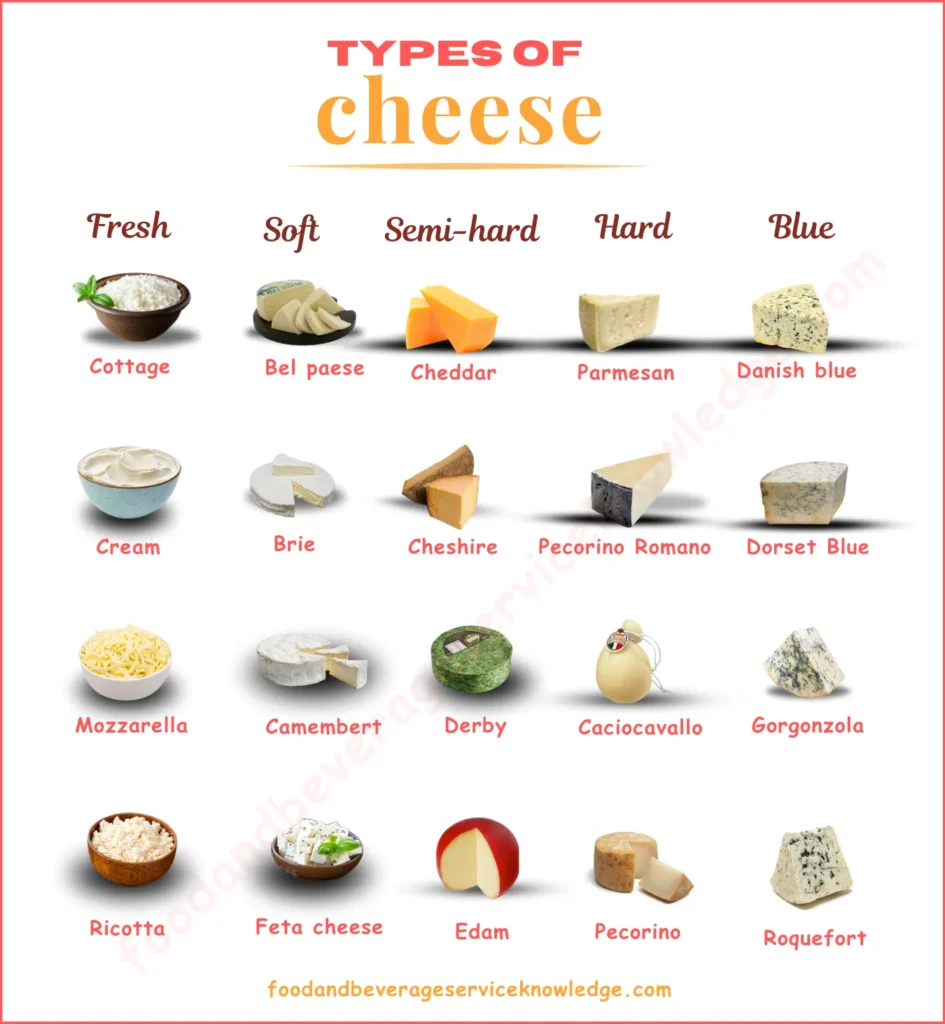
Fresh Cheeses: Creamy and Mild
Fresh cheeses are soft, unaged, and have a mild, creamy flavor. They are versatile in both sweet and savoury dishes, adding richness. With high moisture content, they are smooth, spreadable, or crumbly. Popular varieties include mozzarella, ricotta, feta, and cream cheese.
1. Cottage Cheese

Cottage cheese is a mild, creamy, and slightly tangy fresh cheese made by curdling milk and separating the curds from the whey. Known for its low-fat content and high protein, it is a favourite among health-conscious eaters. Depending on the type, cottage cheese can range from smooth and creamy to chunky (small or large curd).
Origin & History
Cottage cheese traces its roots back to Eastern Europe, where it was traditionally made in small cottages—hence the name. It has been a staple for centuries due to its simple preparation and nutritional value.
Milk Type & Production
Typically made from cow’s milk, cottage cheese is sometimes crafted from goat’s or sheep’s milk for a richer texture. The milk is first pasteurized, then acidified to create curds, which are later rinsed and mixed with a light cream dressing for added flavour.
Uses of Cottage Cheese
- As a Healthy Snack: Eat it plain or mix it with fruits, nuts, honey, or cinnamon for a protein-packed snack.
- In Savoury Dishes: Use it as a creamy topping for salads, toast, or baked potatoes.
- In Cooking & Baking: Add it to lasagna, pancakes, smoothies, or cheesecakes for a boost of flavour and nutrition.
2. Cream Cheese

Cream cheese is a soft, mild-flavoured fresh cheese with a rich, creamy texture. Unlike aged cheeses, cream cheese is meant to be consumed fresh and has a high-fat content, giving it its signature smoothness.
Origin & History
Cream cheese was accidentally created in the 1870s by American dairyman William Lawrence while attempting to replicate the French cheese Neufchâtel. Since then, it has become a staple in kitchens worldwide.
Milk Type & Production
Traditionally made from cow’s milk, cream cheese combines milk and cream to achieve its luscious texture. It is pasteurised and stabilised to maintain its consistency and fresh taste.
Uses of Cream Cheese
- As a Spread: A classic topping for bagels, toast, crackers, and sandwiches.
- In Dips & Spreads: Blended with herbs, yoghurt, or fruit preserves for flavorful dips.
- In Cooking & Baking: A key ingredient in cheesecakes, frostings, pasta sauces, and creamy soups.
Cream cheese’s rich and smooth consistency makes it a go-to ingredient for both sweet and savoury dishes.
3. Mozzarella Cheese
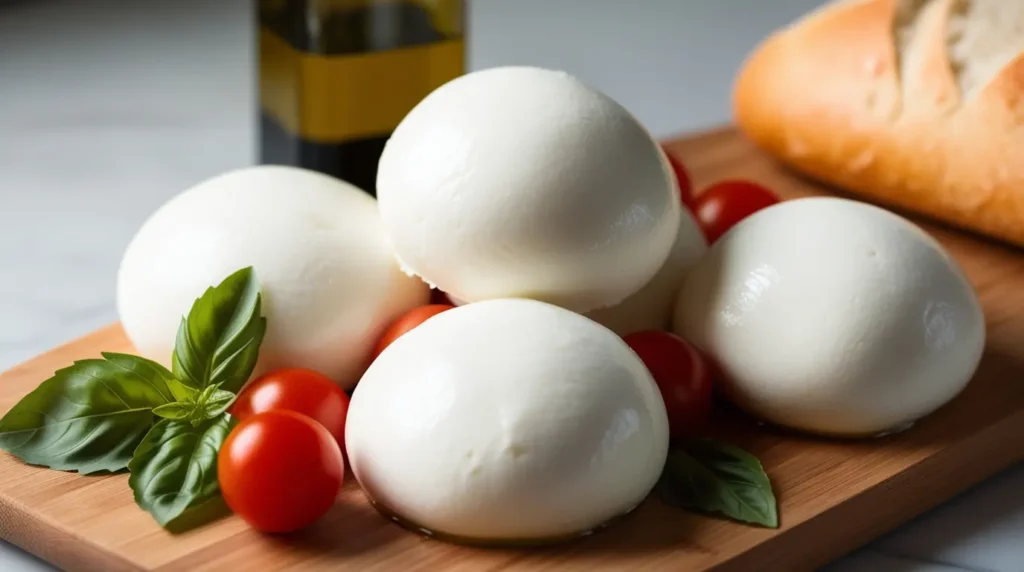
Mozzarella is a fresh Italian cheese known for its smooth texture, mild flavour, and incredible meltability. Traditionally made from Italian buffalo milk or cow’s milk, it undergoes a unique process called pasta filata, where the curds are heated, stretched, and kneaded to achieve its signature elasticity.
Origin & History
Hailing from Italy, mozzarella has been a staple in Italian cuisine for centuries. Originally made from water buffalo milk, it was later adapted to include cow’s milk, making it more widely available worldwide.
Milk Type & Production
Mozzarella is made from buffalo or cow’s milk, with fresh varieties typically stored in brine to maintain moisture. The pasta filata technique gives it its classic stretchiness, making it perfect for melting.
Uses of Mozzarella Cheese
- On Pizza & Pasta: The ultimate cheese for pizza, lasagna, and baked pasta dishes.
- In Caprese Salad, paired with tomatoes, basil, and olive oil for a fresh appetiser.
- As a Melting Cheese: Ideal for paninis, stuffed bread, and cheesy casseroles.
Mozzarella’s soft, stringy texture and mild taste make it a must-have ingredient in both classic and modern dishes.
For more on Mozzarella and its origins, check out Mozzarella on Wikipedia, where you can find detailed information about its history, production methods, and global variations.
4. Ricotta Cheese
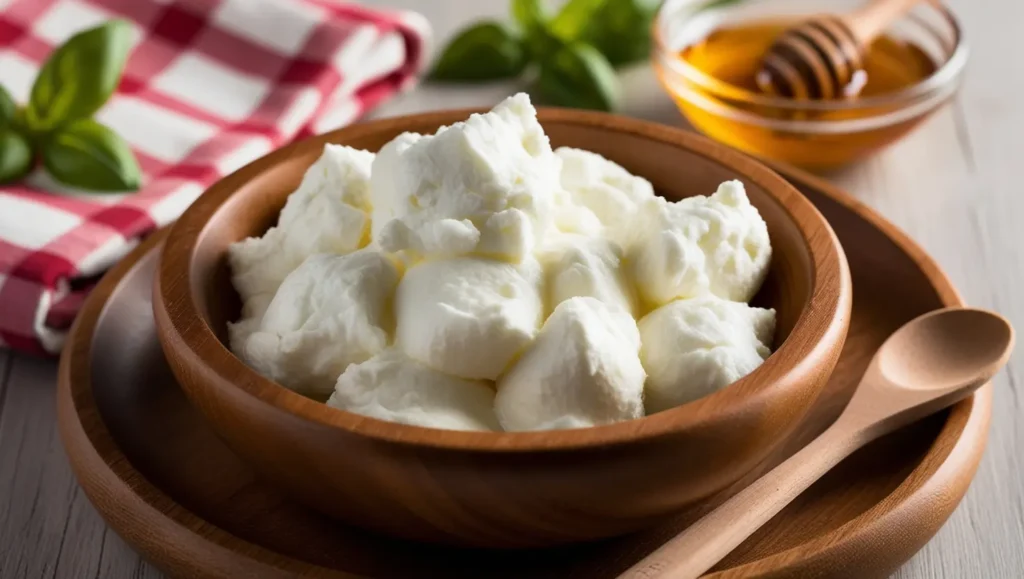
Ricotta is a soft, creamy, and mildly sweet Italian cheese made from the leftover whey of other cheeses like mozzarella and provolone. Known for its light texture and versatility, ricotta is a staple in both savoury and sweet Italian dishes.
Origin & History
Ricotta traces its roots to Italy, where cheesemakers developed the technique of reheating whey (“ricotta” means “recooked” in Italian) to create this smooth and airy cheese.
Milk Type & Production
Traditionally made from cow’s or sheep’s milk, ricotta is produced by heating whey until the proteins coagulate into fine, fluffy curds. This process gives it a soft and spreadable consistency.
Uses of Ricotta Cheese
- In Italian Desserts: A key ingredient in cheesecakes, cannoli, and ricotta-filled pastries.
- In Savory Dishes: Adds creaminess to pasta dishes like lasagna and stuffed shells.
- As a Spread: Delicious on toast with honey, herbs, or fruit.
Ricotta’s light, creamy texture makes it a favourite for both indulgent sweets and hearty meals.
5. Queso Fresco

Queso Fresco is a soft, mild, and slightly tangy Mexican fresh cheese. It has a crumbly texture that softens when heated but doesn’t fully melt, making it a popular topping for various Mexican dishes.
Origin & History
Queso Fresco originated in Mexico, influenced by Spanish cheesemaking traditions. It remains a staple in Latin American cuisine.
Milk Type & Production
Traditionally made from cow’s milk or a mix of cow and goat milk, Queso Fresco is created by adding rennet or an acid like lemon juice or vinegar to warm milk, forming curds that are then drained and pressed.
Uses of Queso Fresco
- In Mexican Cuisine: Crumbled over tacos, enchiladas, and tamales for a fresh, tangy bite.
- As a Garnish: Adds a creamy contrast to salads, beans, and soups.
- In Breakfast Dishes: Served with eggs, chilaquiles, or alongside fresh fruit.
Soft-Ripened Cheeses: Creamy and Velvety
Soft-ripened cheeses have a bloomy rind and a luscious, creamy centre. They ripen from the outside in, developing a rich and buttery texture. Their delicate, edible rind adds depth to their mild, earthy flavours.
These cheeses pair beautifully with fruits, nuts, and crusty bread. Popular varieties include Brie, Camembert, and Triple Cream cheeses.
6. Bel Paese
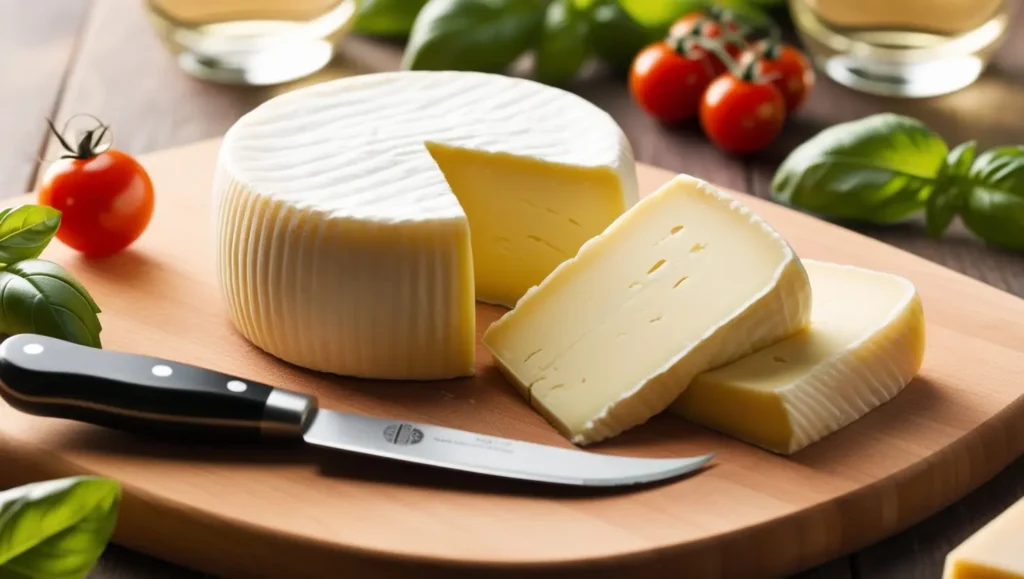
Bel Paese is a soft, creamy Italian cheese with a mild, buttery flavour and a smooth texture. Its name, which means “beautiful country” in Italian, reflects its rich heritage. Aged for six to eight weeks, Bel Paese has a pale yellow colour and a delicate aroma, making it a favourite among cheese lovers.
Origin & History
Bel Paese was created in Italy in the early 20th century by Egidio Galbani, who wanted to produce a cheese that would rival French soft cheeses. Today, it remains a staple in Italian cuisine.
Milk Type & Production
Made from cow’s milk, Bel Paese is crafted through a gentle ageing process that gives it a smooth, melt-in-your-mouth consistency.
Uses of Bel Paese Cheese
- In Cooking: Melts easily, making it perfect for pizzas, casseroles, and pasta dishes.
- In Desserts: Often used in cheesecakes and pastries for a mild, creamy texture.
- With Wine & Bread: Pairs well with fruity wines and crusty bread for a simple, elegant snack.
7. Brie
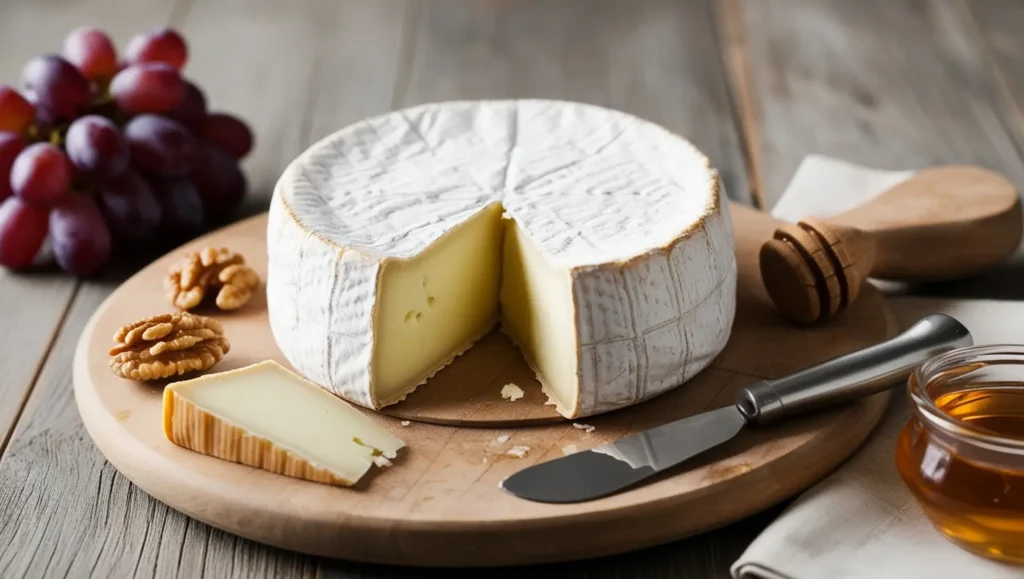
Brie is one of the most famous French cheeses, known for its creamy texture, rich flavour, and edible white rind. As it ripens, the interior becomes soft and buttery, making it a favourite for cheese lovers worldwide.
Origin & History
Brie originates from the Île-de-France region of France and dates back to the 8th century. It was once considered a “cheese of royalty”, enjoyed by French nobility. Today, it remains a symbol of French culinary excellence.
Milk Type & Production
Traditionally made from cow’s milk, Brie undergoes a soft-ripening process, developing its signature bloomy rind and smooth, spreadable interior.
Uses of Brie Cheese
- On a Cheese Platter: Pairs perfectly with fruits, nuts, honey, and crusty bread.
- In Appetisers & Snacks: Enjoy baked Brie with jam or wrapped in puff pastry.
- In Cooking: Adds richness to sandwiches, tarts, and pastries.
8. Camembert
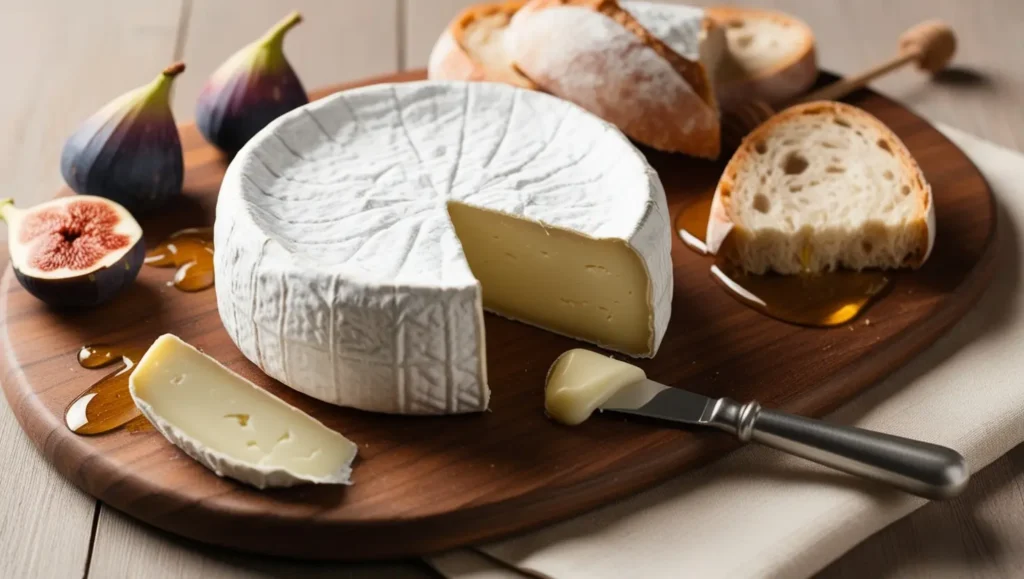
Camembert is a soft, creamy, surface-ripened cheese made from cow’s milk. It has a delicate, bloomy white rind and a smooth, buttery interior that becomes richer and more flavorful as it matures.
Origin & History
Camembert cheese originated in the late 18th century in Camembert, Normandy, France. It is credited to Marie Harel, a farmer who developed the recipe, making it one of France’s most iconic cheeses.
Milk Type & Production
Made from cow’s milk, Camembert undergoes a surface-ripening process that allows it to develop its distinctive creamy texture and earthy aroma over three weeks.
Uses of Camembert Cheese
- On a Cheese Board: Pair with fruits, nuts, and crusty bread for an elegant appetiser.
- Baked Camembert: Bake it whole for a warm, gooey dip, perfect with crackers or baguette slices.
- In Sandwiches: Add to grilled cheese, paninis, or croissants for a rich, creamy taste.
- In Pastries: Use in tarts or wrap in puff pastry for a gourmet treat.
9. Feta

Feta is a brined, white, soft cheese known for its salty, tangy flavour and creamy yet crumbly texture. Traditionally made from sheep’s milk or a blend of sheep’s and goat’s milk, Feta is a staple in Mediterranean cuisine.
Origin & History
Feta cheese has its roots in Greece, dating back thousands of years. It is an integral part of Greek culinary heritage, often associated with the Mediterranean diet.
Milk Type & Production
Authentic Feta is made from sheep’s milk or a mix of sheep’s and goat’s milk. It is aged in a brine solution, which helps preserve its moisture and enhance its sharp, tangy taste.
Uses of Feta Cheese
- In Salads: A key ingredient in Greek salads, paired with cucumbers, tomatoes, olives, and red onions.
- In Pastries: Used in savoury Greek pastries like spanakopita (spinach pie).
- With Olive Oil & Herbs: Served as an appetiser with olive oil, oregano, and olives.
- In Cooking: Crumbled over roasted vegetables, pasta dishes, or grilled meats for extra flavour.
10. Neufchâtel
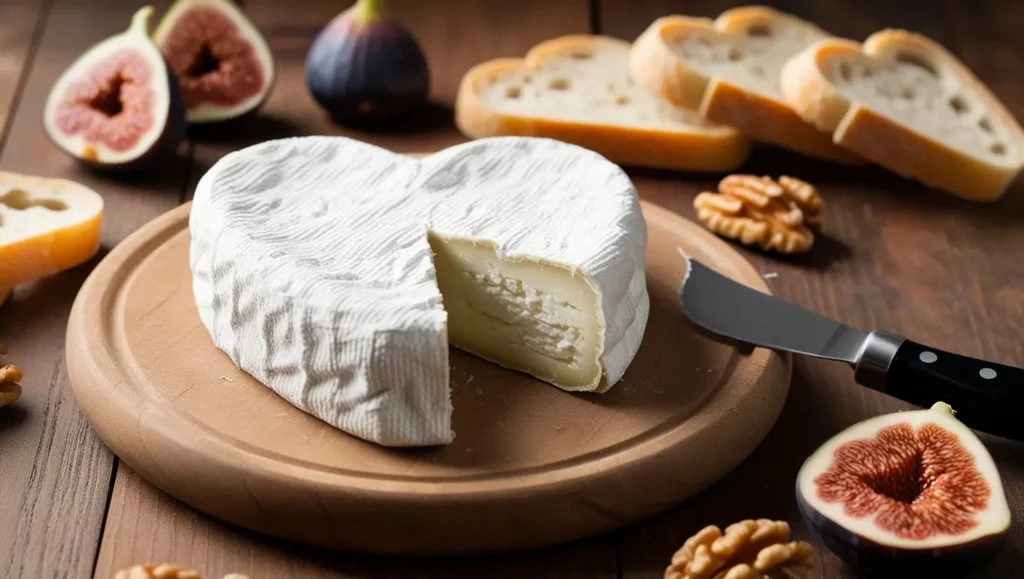
Neufchâtel is a soft, mould-ripened cheese from France, known for its slightly crumbly texture and mild, tangy flavour. Often shaped into hearts, this cow’s milk cheese is one of the oldest cheeses in France, dating back to the 6th century.
Origin & History
Hailing from Neufchâtel-en-Bray in Normandy, France, Neufchâtel has been produced for centuries. Its heart-shaped form is said to have originated from French dairymaids gifting it to their lovers.
Milk Type & Production
Made from cow’s milk, Neufchâtel undergoes 8 to 10 weeks of age, during which it develops a white, edible rind similar to Brie or Camembert.
Uses of Neufchâtel Cheese
- As a Spread: Enjoy it on bagels, toast, or crackers as a lighter alternative to cream cheese.
- In Desserts: Use it in cheesecakes or baked goods for a mild, tangy twist.
- On a Cheese Board: Pairs beautifully with fruits, nuts, and honey.
- In Savoury Dishes: Incorporate it into dips, sauces, and stuffed chicken breasts for added richness.
11. Coulommiers

Coulommiers is a soft-ripened French cheese with a creamy texture and rich, buttery flavour. It is often considered a smaller, denser version of Brie, but with a slightly stronger and earthier taste due to its thicker interior and the longer ageing process.
Origin & History
Coulommiers cheese originates from the Île-de-France region of France, the same area famous for Brie. It has been made since the Middle Ages and is often enjoyed as an artisanal cheese.
Milk Type & Production
Made from cow’s milk, Coulommiers develops a white, bloomy rind as it ages. It is aged for about 4 to 6 weeks, allowing it to develop its distinctive creamy consistency and slight nutty undertones.
Uses of Coulommier’s Cheese
- Cheese Board Favourite: Serve it with fruits, nuts, and crusty bread.
- Melts Beautifully: Perfect for grilled cheese sandwiches, tarts, and baked dishes.
- Pairs Well with Wine: Enjoy it with a light red wine like Pinot Noir or a sparkling white wine.
Semi-Hard Cheeses: Smooth and Mellow
Semi-hard cheeses have a firm yet smooth texture with mild, nutty flavours. They slice easily and melt beautifully, making them perfect for cooking. These cheeses are versatile and commonly used in sandwiches and hot dishes. Ageing enhances their depth of flavour while maintaining a balanced taste. Popular varieties include Gouda, Edam, and Monterey Jack.
12. Cheddar Cheese
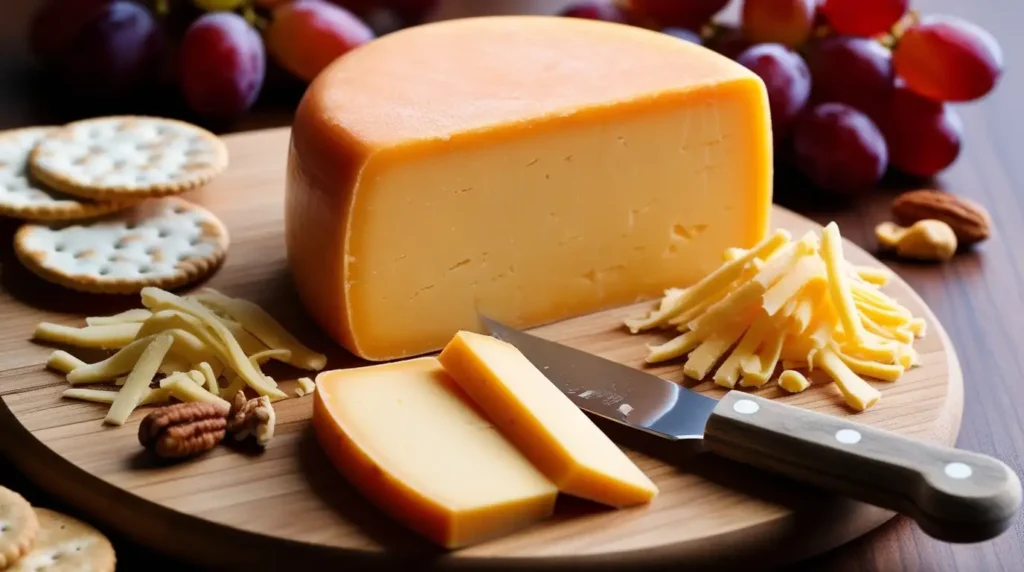
Cheddar is one of the most popular semi-hard cheeses worldwide, known for its rich, sharp flavour and smooth texture. It is made from cow’s milk and undergoes a unique process called cheddaring, which involves cutting, stacking, and pressing the curds to achieve its distinct firm consistency. Cheddar cheese can be aged from 3 months to several years, with older varieties developing a stronger, sharper taste.
Origin & History
Cheddar cheese originated in the village of Cheddar, Somerset, England, dating back to at least the 12th century. It has since become a global favourite, produced in different styles, from mild and creamy to extra sharp and crumbly.
Milk Type & Production
Traditionally made from cow’s milk, Cheddar develops a dense, slightly crumbly texture as it matures. The ageing process significantly influences its flavour:
- Mild Cheddar (aged 3–6 months) is smooth and creamy.
- Sharp Cheddar (aged 9–18 months) has a bold, tangy bite.
- Extra Sharp Cheddar (aged 2+ years) is intensely flavorful with a crumbly texture.
Uses of Cheddar Cheese
- In Cooking & Melting: Perfect for burgers, grilled cheese sandwiches, and baked dishes like macaroni and cheese or casseroles.
- Snacking & Cheese Boards: Enjoy with crackers, apples, grapes, or nuts for a balanced pairing.
- Grated or Shredded: Adds a rich, savoury taste to soups, salads, tacos, and omelettes.
Aged Cheddar is also a fantastic pairing with wine—sharp varieties complement full-bodied reds, while milder Cheddar pairs well with white wines and ciders.
13. Cheshire Cheese
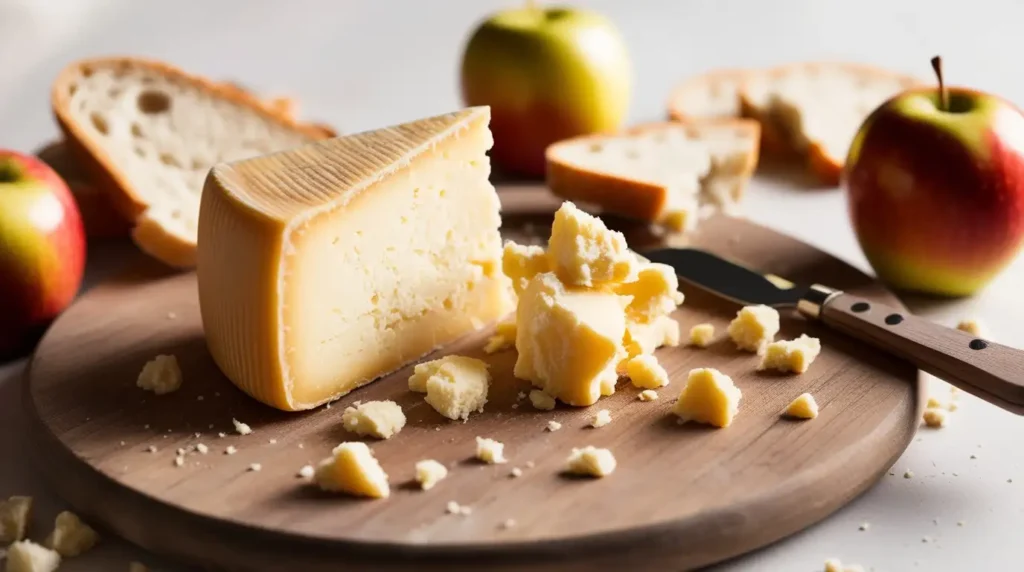
Cheshire cheese is one of England’s oldest cheeses, known for its crumbly texture and slightly salty, tangy flavour. Named after the county of Cheshire, this semi-hard cheese has been produced for centuries and matures within 4 to 8 weeks.
Varieties of Cheshire Cheese
Cheshire cheese comes in three distinct types:
- White Cheshire – The most common variety, mild and creamy with a slight tang.
- Red Cheshire – Similar in taste but coloured with annatto, giving it a distinctive orange hue.
- Blue Cheshire – A rarer variety with blue veins, offering a more intense and tangy flavour.
Origin & History
Cheshire cheese dates back to Roman times, making it one of Britain’s oldest recorded cheeses. It was a staple for sailors due to its long shelf life and high nutritional value.
Milk Type & Production
Traditionally made from cow’s milk, Cheshire cheese develops a dense yet crumbly texture, making it easy to slice, crumble, or melt.
Uses of Cheshire Cheese
- On Cheese Boards – Pairs beautifully with fruits, nuts, and crackers.
- In Cooking – Enhances soups, sauces, and pies with its rich flavour.
- Grated Over Dishes – Perfect for salads, baked goods, and savoury pastries.
Its crumbly yet creamy texture makes it ideal for melting, adding a depth of flavour to traditional British dishes like Welsh rarebit or cheese and onion pie.
14. Derby Cheese
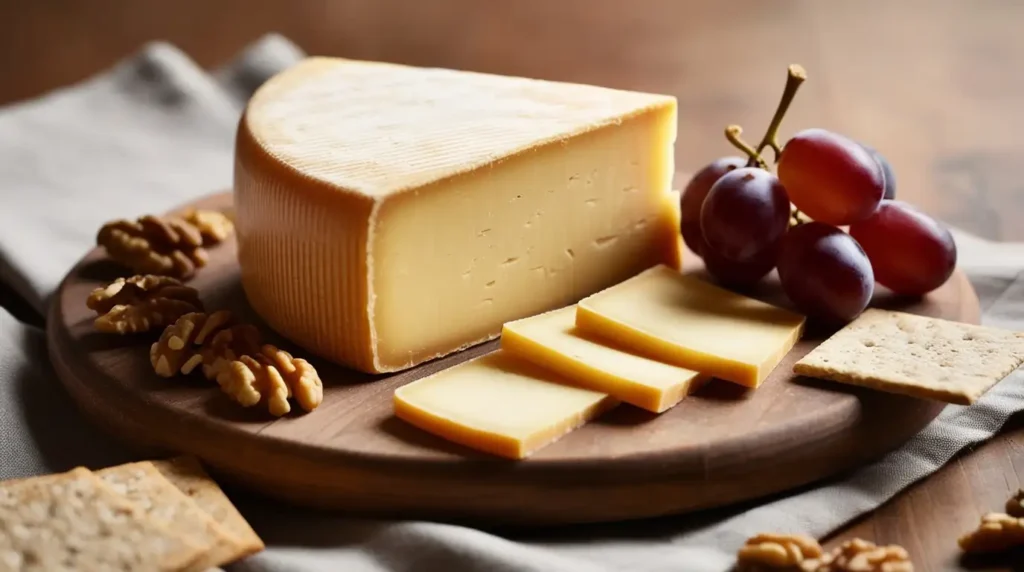
Derby cheese, also known as Derbyshire cheese, is a semi-hard, traditional English cheese with a mild, buttery flavour and a smooth, creamy texture. It has a pale golden-orange hue and is usually aged between one to six months, developing a delicate yet rich taste.
Origin & History
Derby cheese originates from Derbyshire, England, where it has been produced for centuries. It is one of Britain’s oldest cheeses, known for its versatility and creamy consistency.
Milk Type & Production
Made from cow’s milk, Derby cheese develops a natural waxed rind that helps preserve its mild yet distinct flavor.
Uses of Derby Cheese
- On Cheese Boards – Pairs beautifully with fruits, nuts, and crackers, enhancing its creamy profile.
- For Melting – Ideal for sandwiches, grilled cheese, and savoury dishes, as it melts smoothly.
- In Cooking – Adds a rich, mild creaminess to quiches, pies, and casseroles.
15. Edam Cheese

Edam cheese is a semi-hard Dutch cheese, known for its slightly salty, nutty flavour and smooth, firm texture. It is easily recognizable by its distinctive round shape and red wax coating. As Edam ages, its texture becomes firmer, and its flavour develops a sharper, more complex taste.
Origin & History
Edam cheese originates from the town of Edam in North Holland, Netherlands. It was widely exported during the 17th and 18th centuries, making it one of the most popular cheeses in Europe.
Milk Type & Production
Traditionally made from cow’s milk, Edam can also be produced using goat’s milk, which gives it a slightly tangier taste.
Uses of Edam Cheese
- With Fruits & Crackers – Pairs beautifully with pears, apples, and grapes, enhancing its mild sweetness.
- On Cheese Boards – Complements nuts, bread, and spreads for a balanced tasting experience.
- With Wine – Best enjoyed with Riesling, Chardonnay, or sparkling wine to bring out its nutty richness.
- In Cooking – Used in soups, salads, sandwiches, and baked dishes for a creamy, mild boost of flavour.
16. Emmental Cheese

Emmental also spelled Emmenthal, is a semi-hard Swiss cheese known for its pale yellow colour, smooth texture, and characteristic holes. It has a mild, nutty, and slightly sweet flavour, making it a versatile favourite in both cold and hot dishes.
Origin & History
Emmental cheese originates from the Emmental region in Switzerland, dating back to the 13th century. It is classified as a Swiss-type or Alpine cheese, known for its large holes, which form due to gas bubbles released by bacteria during the fermentation process.
Milk Type & Production
Emmental is traditionally made from cow’s milk, using three essential bacteria:
- Streptococcus thermophilus
- Lactobacillus helveticus
- Propionibacterium freudenreichii
These bacteria contribute to its smooth texture and unique hole formation.
Uses of Emmental Cheese
- Eaten Cold – Enjoyed in slices or chunks on sandwiches, cheese boards, or with crackers.
- Melting & Cooking – A key ingredient in fondue, gratins, and soups due to its excellent melting properties.
- Fruits & Nuts – Pairs well with apples, pears, grapes, and almonds for a balanced taste.
- In Hot Dishes – Adds creamy richness to burgers, omelettes, and quiches.
17. Gloucester Cheese
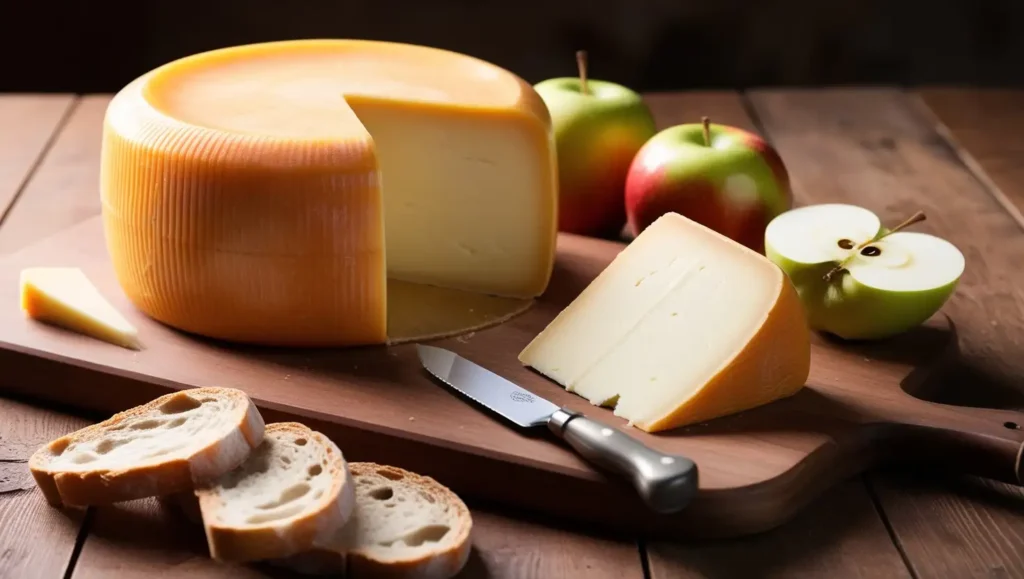
Gloucester cheese is a traditional English semi-hard cheese originating from Gloucestershire, England. It is smooth, creamy, and full-flavoured, with a buttery and slightly nutty taste. Traditionally, it was made using milk from the rare Gloucester cattle breed.
There are two types of Gloucester cheese:
- Double Gloucester – Aged longer, richer, and more flavorful, with a smooth, firm texture.
- Single Gloucester – Milder, crumblier, and lower in fat, with a lighter texture.
Origin & History
Gloucester cheese dates back to the 16th century and was originally made exclusively in Gloucestershire. Double Gloucester was the preferred choice for ageing, while Single Gloucester was often consumed fresh.
Milk Type & Production
Both variations are traditionally made from cow’s milk. Double Gloucester has a deeper golden hue, often enhanced with annatto, a natural colouring.
Uses of Gloucester Cheese
- Double Gloucester – With its rich, creamy texture, it is ideal for cheese boards, slicing, and melting. It pairs well with crackers, bread, and chutneys. It also melts beautifully, making it perfect for grilled cheese sandwiches, quiches, and pasta dishes.
- Single Gloucester – With a crumbly texture and mild flavour, it is commonly used for grating over salads or incorporated into savoury dishes.
18. Gouda Cheese
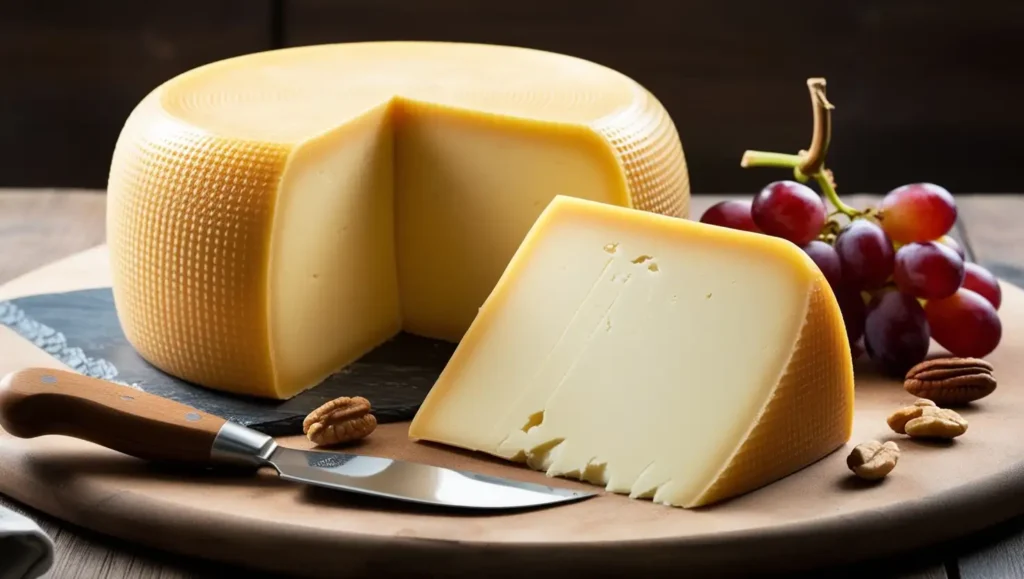
Gouda is a semi-hard Dutch cheese prized for its smooth, creamy texture and mild, slightly sweet flavour. As it ages, it develops a richer, nuttier taste and a firmer consistency. One of the most widely consumed cheeses in the world, Gouda is enjoyed both in its young, soft form and as an aged, more complex variety.
Origin & History
Gouda cheese originated in the Netherlands, named after the city of Gouda, where it has been traded since the 12th century. It remains a cornerstone of Dutch cheese culture and is now produced globally.
Milk Type & Production
Traditionally made from cow’s milk, Gouda has a golden-yellow interior with a red or yellow wax coating that helps preserve its moisture and flavour.
Uses of Gouda Cheese
- Melts perfectly – Ideal for grilled cheese sandwiches, burgers, and creamy pasta sauces.
- Perfect for Cheese Boards – Pairs beautifully with fruits, nuts, and crackers.
- Great with Drinks – Complements port wine, Riesling, Chardonnay, and strong beers.
With its rich, buttery flavour and smooth melting qualities, Gouda is a versatile favourite for both cooking and snacking.
For a deeper dive into the rich history and variety of Gouda cheese, check out Wisconsin Cheese – Gouda. You’ll find detailed insights into its production, ageing process, and the many delicious varieties of this iconic cheese.
19. Gruyère Cheese
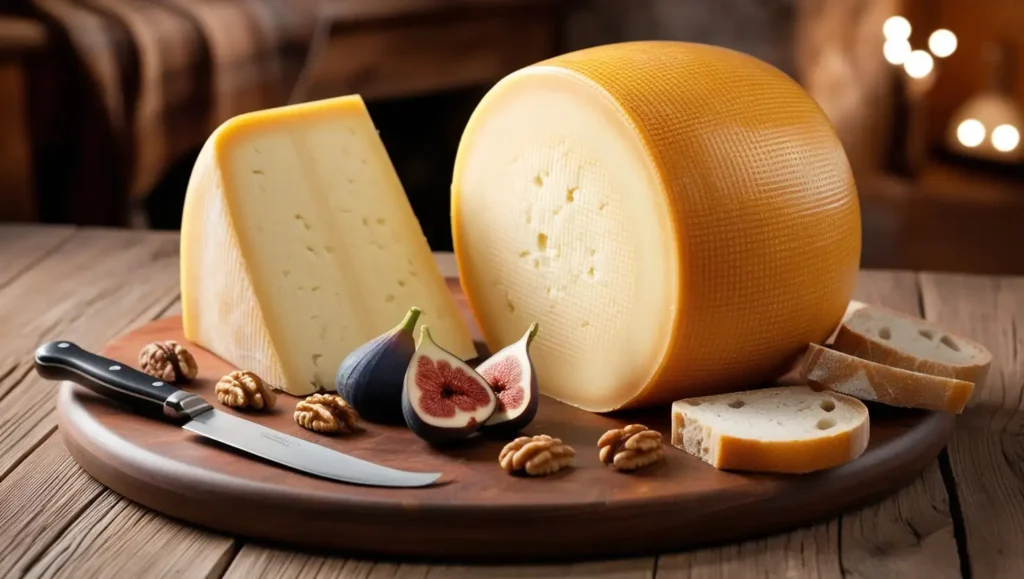
Gruyère is a semi-hard Swiss cheese, known for its firm yet smooth texture and rich, nutty flavour. It is often recognized by its small, pea-sized holes and a golden-yellow colour. Depending on its age, Gruyère can taste creamy and slightly sweet when young, or bold and earthy when aged.
Origin & History
Named after the town of Gruyères in Switzerland, this cheese has been crafted for centuries, using traditional Alpine cheese-making techniques. Gruyère is carefully aged for several months to over a year, allowing its flavour to mature and deepen.
Milk Type & Production
Gruyère is made from cow’s milk, undergoing a slow ageing process that enhances its complex flavours and smooth consistency.
Uses of Gruyère Cheese
- Perfect Melting Cheese – Used in French onion soup, grilled cheese sandwiches, and pasta dishes.
- Great for Baking – A key ingredient in quiches, soufflés, and savoury tarts.
- Ideal for Cheese Boards – Pairs beautifully with fruits, nuts, and crusty bread.
Gruyère’s nutty depth and smooth melt make it a must-have for both cooking and snacking, bringing a touch of Swiss tradition to every bite.
20. Port Salut Cheese
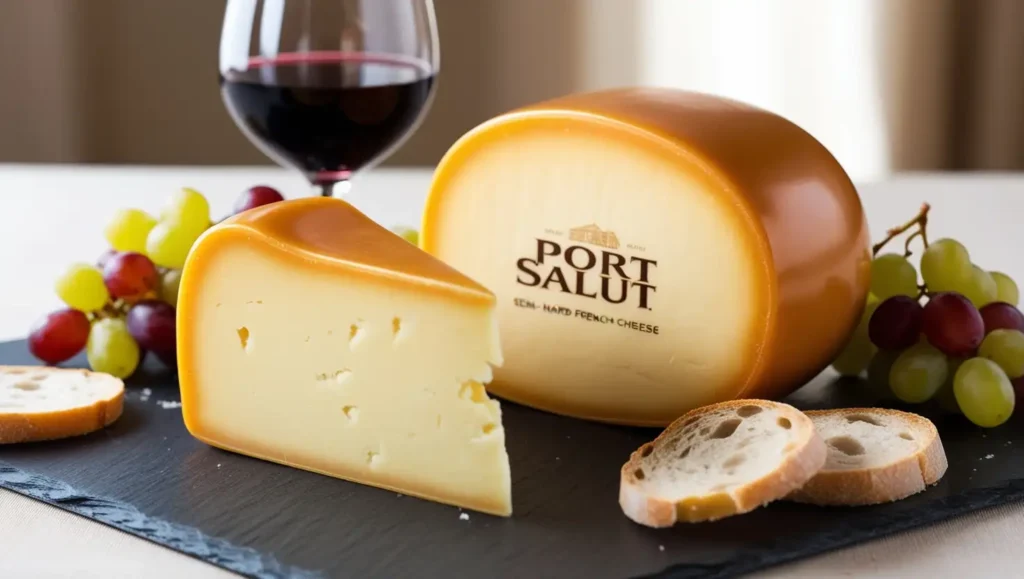
Port Salut is a semi-hard French cheese known for its creamy texture and mellow, sweet, and savoury flavor. It is easily recognized by its smooth, orange rind and pale yellow interior. Originally crafted by Trappist monks in the 19th century, Port Salut has become a widely enjoyed cheese both in France and internationally.
Origin & History
Port Salut was first created in the Loire Valley, France, by Trappist monks seeking a mild and smooth cheese. Over time, it gained popularity and is now produced by various dairies worldwide.
Milk Type & Production
Made from pasteurized cow’s milk, Port Salut is aged for a short period, resulting in its buttery texture and mild, slightly tangy taste.
Uses of Port Salut Cheese
- Perfect for Cheese Boards – Pairs well with fruits, nuts, and crackers.
- Great for Melting – Used in sandwiches, pizzas, and creamy sauces.
- Ideal for Cooking – Adds richness to quiches, gratins, and savoury tarts.
With its smooth, mild flavour and excellent melting qualities, Port Salut is a versatile cheese that complements both sweet and savoury dishes.
21. Manchego Cheese
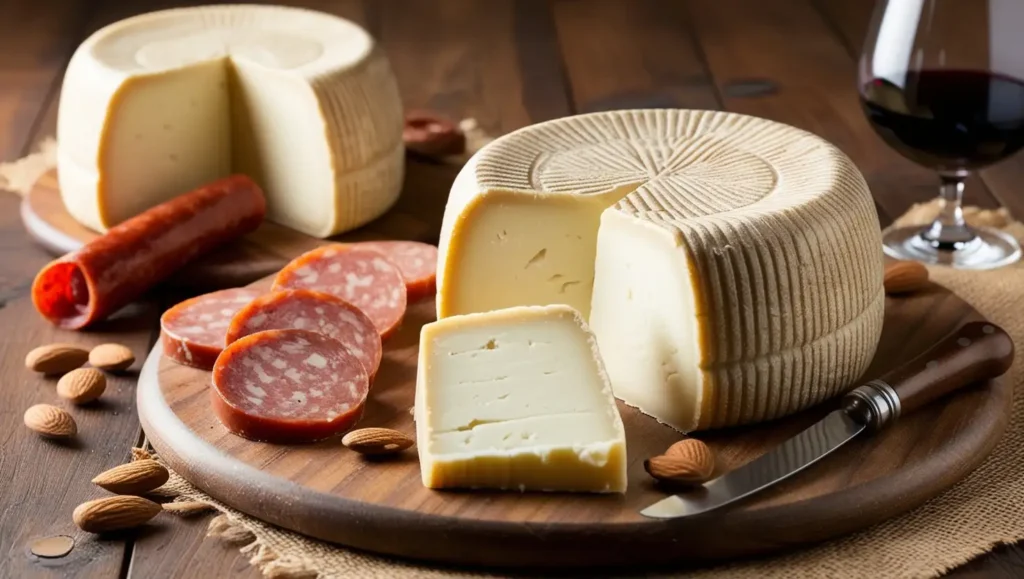
Manchego is a well-known Spanish semi-hard cheese made from sheep’s milk. It has a firm yet creamy texture and a distinctive nutty, slightly tangy flavour. Manchego is easily recognizable by its characteristic herringbone-patterned rind, which is a result of the traditional grass moulds used during production. Depending on its aging period, Manchego can range from mild and creamy to firm and sharp.
Origin of Manchego Cheese:
Manchego originates from the La Mancha region of Spain, where it has been produced for centuries.
Milk Type:
Manchego cheese is made exclusively from the milk of Manchega sheep, which graze in the central plains of Spain.
Uses of Manchego Cheese:
- Cheese Boards: Often paired with quince paste (membrillo), nuts, and Spanish wines.
- Snacking & Tapas: Served in slices with olives, bread, or drizzled with honey.
- Cooking: Grated over salads, melted into dishes, or used in traditional Spanish recipes.
Hard Cheeses: Rich and Flavorful
Hard cheeses are aged to develop a firm texture and bold, complex flavours. Their dense consistency makes them ideal for grating, slicing, or snacking.
These cheeses add depth to dishes, from pasta and soups to salads and sauces. Ageing enhances their nutty, sharp, or savoury profiles, making them stand out. Popular varieties include Parmesan, Pecorino Romano, and Gruyère.
22. Parmesan Cheese
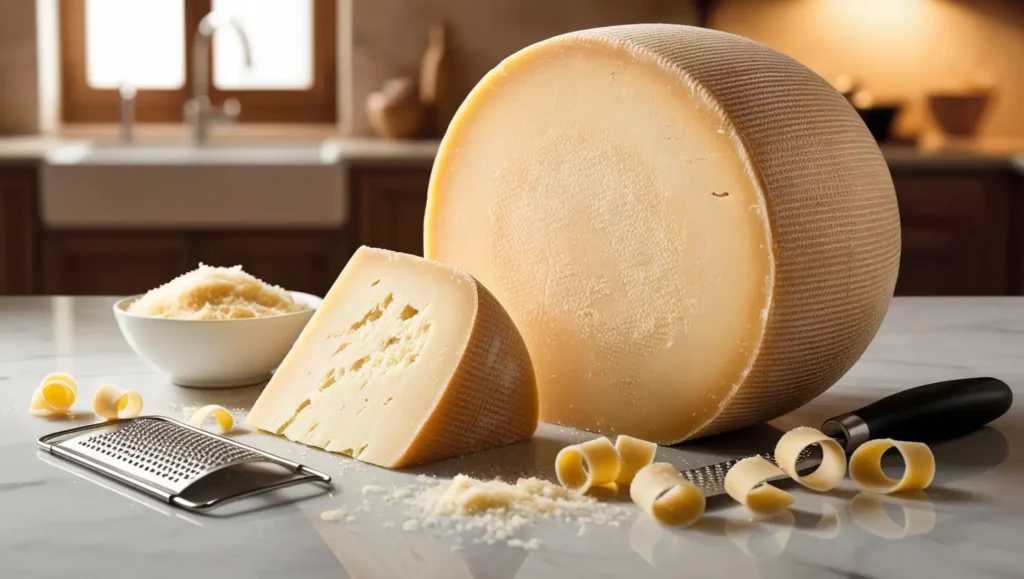
Parmesan cheese, known in Italy as Parmigiano-Reggiano, is a hard, granular cheese made from cow’s milk. It is celebrated for its sharp, nutty flavour and gritty texture, which comes from its long ageing process. Parmesan is one of the most famous and widely used cheeses in Italian cuisine.
Origin & History
Parmesan cheese originated in Italy and is traditionally produced in Parma, Reggio Emilia, Modena, and parts of Bologna and Mantua. It follows strict production regulations to earn the Parmigiano-Reggiano designation.
Milk Type & Production
Made from cow’s milk, Parmesan is aged for at least 12 months, with premium varieties aging 24 months or more. This long ageing process enhances its complex flavours and makes it more crumbly.
Uses of Parmesan Cheese
- Grated Over Pasta & Risotto – Enhances dishes like spaghetti, lasagna, and risotto.
- Flavor Booster for Soups & Salads – Adds depth when sprinkled over soups, vegetables, and salads.
- Topping for Snacks – Used on popcorn, roasted nuts, and even crackers for a savory kick.
With its rich umami taste, Parmesan is a staple in Italian cooking and a must-have ingredient for anyone who loves bold, aged cheeses.
23. Pecorino Romano

Pecorino Romano is a hard, aged cheese made from sheep’s milk, known for its sharp, salty flavour and crumbly texture. One of Italy’s oldest cheeses, it has been a staple in Roman cuisine for over 2,000 years. It is widely used in Italian dishes, especially as a grating cheese.
Origin & History
Pecorino Romano originated in ancient Rome and has been traditionally produced in Lazio, Sardinia, and Tuscany. It was once a vital part of the Roman soldier’s diet due to its long shelf life and high nutritional value.
Milk Type & Production
Made from sheep’s milk, giving it a bold, tangy taste., Aged for at least 8 months, though some varieties mature for over a year, intensifying the flavour.
Uses of Pecorino Romano
- Perfect for Grating – A key ingredient in classic dishes like Cacio e Pepe and Carbonara.
- Enhances Soups & Risottos – Adds depth and saltiness when sprinkled over warm dishes.
- Pairs with Honey & Fruits – The sharp, salty taste balances beautifully with honey, pears, or figs.
24. Caciocavallo
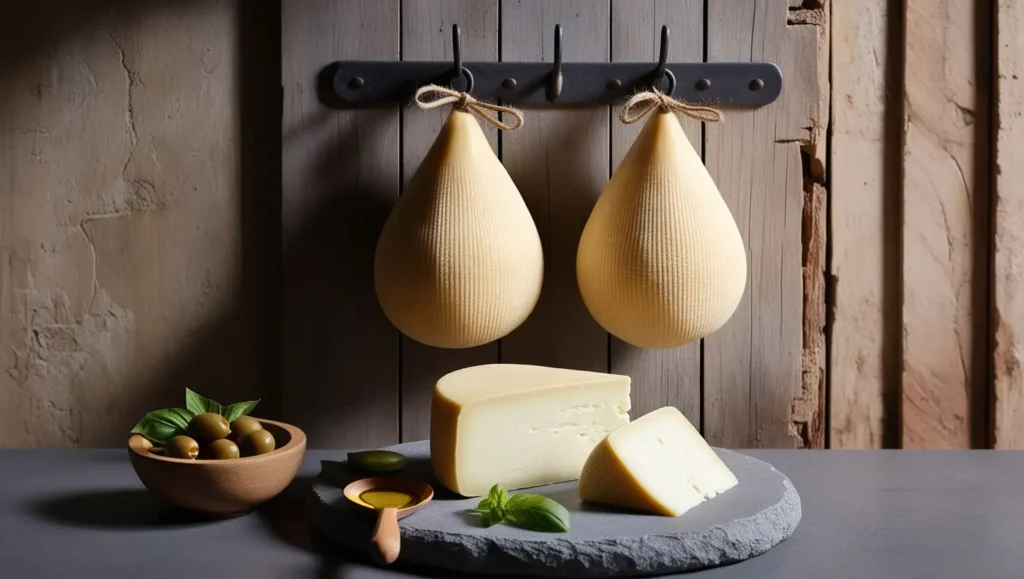
Caciocavallo is a traditional stretched-curd cheese from Southern Italy, known for its distinct teardrop shape and firm, slightly tangy flavor. It is made from cow’s milk or a blend of cow’s and sheep’s milk, and its taste becomes sharper and more complex as it ages.
Origin & History
Caciocavallo originated in Southern Italy, particularly in the Apennine Mountains and the Gargano Peninsula. The name “Caciocavallo” means “cheese on horseback,” referring to the traditional method of tying and hanging the cheese over wooden beams to age.
Milk Type & Production
Made from cow’s milk or a mix of cow’s and sheep’s milk, Aged for several months to a year, developing a firm texture and deep, savoury taste.
Uses of Caciocavallo Cheese
- Grated Over Pasta & Casseroles – Enhances dishes like baked pasta with its bold, slightly tangy flavor.
- Melts Beautifully in Sandwiches – Perfect for paninis, grilled cheese, or melted over roasted vegetables.
- Paired with Fruits & Meats – Complements figs, nuts, and cured meats on a charcuterie board.
With its rich, aged flavours, Caciocavallo is a beloved cheese in Southern Italian cuisine! 🇮🇹🧀
25. Grana Padano
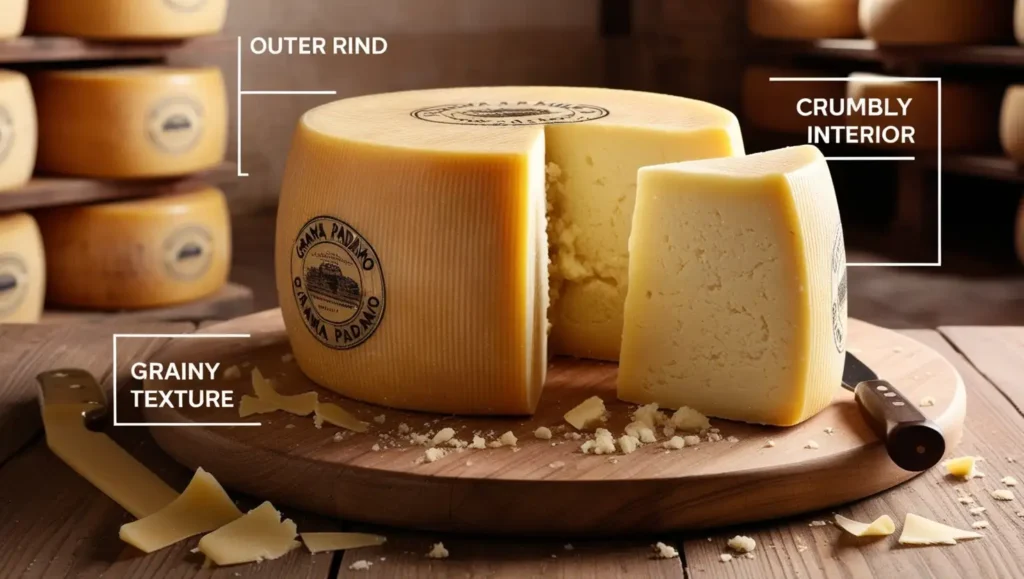
Grana Padano is a hard, aged Italian cheese known for its grainy texture and savoury, nutty flavour. Made from cow’s milk, it is similar to Parmesan but has a slightly milder and creamier taste.
Origin & History
Grana Padano originated in northern Italy, particularly in the Po River Valley, during the 12th century. Created by Cistercian monks, it remains one of Italy’s oldest and most famous cheeses, protected under the PDO (Protected Designation of Origin) system.
Milk Type & Production
Made from cow’s milk, aged for 9 to 24 months. Develops a crumbly, granular texture and a rich, nutty taste with ageing.
Uses of Grana Padano Cheese
- Grated Over Pasta & Risotto – A staple in Italian dishes, adding a savoury depth.
- Shaved on Salads & Soups – Enhances Caesar salads, minestrone, and roasted vegetables.
- Paired with Wine & Fruits – Complements red wines, figs, pears, and honey for a gourmet experience.
Blue Cheeses: Bold and Tangy
Blue cheeses are distinguished by their blue or green veins of mould, giving them a sharp, tangy flavour.
Their creamy to crumbly textures vary based on ageing, from mild to intensely pungent. They pair beautifully with fruits, nuts, and honey, balancing their bold taste. Often used in salads, sauces, and steaks, they add a rich depth to dishes. Famous varieties include Roquefort, Gorgonzola, and Stilton.
26. Danish Blue
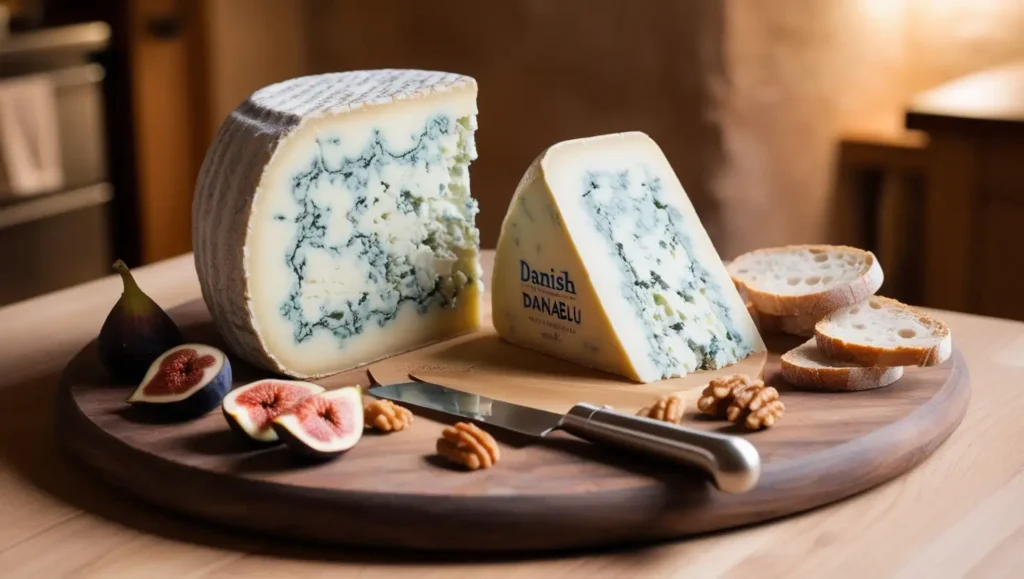
Danish Blue cheese, also known as Danablu, is a semi-soft, blue-veined cheese made from cow’s milk. It is known for its creamy texture, bold tangy flavour, and striking blue-green mould veins, which develop during the ageing process.
Origin & History
Danish Blue cheese originated in Denmark in the early 20th century, created by Marius Boe, a Danish cheesemaker. Inspired by Roquefort, he developed this cheese using cow’s milk instead of sheep’s milk, making it milder and creamier.
Milk Type & Production
Made from cow’s milk, aged for 8 to 12 weeks., Develops a soft, crumbly texture with a sharp, salty taste.
Uses of Danish Blue Cheese
- Crumbled Over Salads – Enhances salads with fruits, nuts, and honey for a sweet-savory balance.
- Melted into Sauces – Adds richness to creamy dressings, pasta sauces, and steak toppings.
- Paired with Crackers & Wine – Complements bold red wines, honey, and crusty bread on cheese boards.
27. Dorset Blue Vinny

Dorset Blue Vinny, commonly known as Dorset Blue, is a traditional English blue cheese made from skimmed cow’s milk. It has a crumbly yet moist texture, with a tangy, salty flavour and distinctive blue veins running throughout. Aged for at least 6 weeks, it develops a bold and complex taste.
Origin & History
Dorset Blue Vinny originates from Dorset, United Kingdom, where it has been handmade for centuries. Historically, it was produced using skimmed milk left over from butter-making, resulting in a leaner cheese.
Milk Type & Production
Made from skimmed cow’s milk for a lean yet flavorful profile., Aged for 6 weeks, developing a hard, crumbly texture with blue mould veins.
Uses of Dorset Blue Vinny
- Crumbled Over Salads – Adds a sharp, tangy flavour to leafy greens, nuts, and fruit.
- Paired with Bread & Crackers – Complements hearty bread, oatcakes, and honey.
- Used in Cooking – Melts into soups, sauces, and pasta dishes for an earthy richness.
28. Gorgonzola
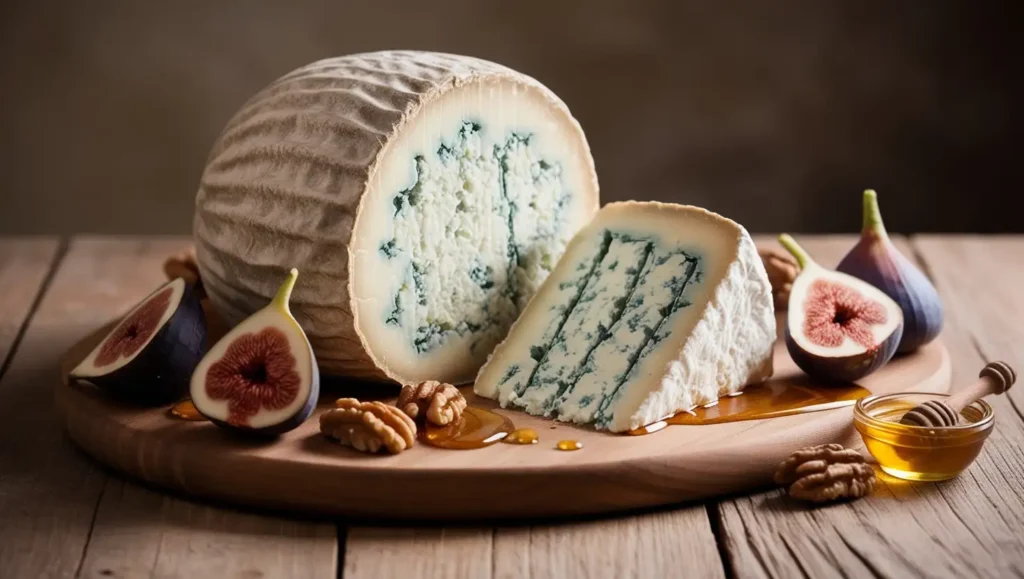
Gorgonzola is a famous Italian blue cheese known for its creamy, crumbly texture and distinctive blue-green veins of mould. Made from cow’s milk, it has a rich, tangy flavour that varies depending on the ageing process. Gorgonzola comes in two main varieties:
- Gorgonzola Dolce – Soft, creamy, and mildly sweet.
- Gorgonzola Piccante – Aged longer, firmer, and more pungent.
Origin & History
Gorgonzola originates from Lombardy and Piedmont, Italy, and is one of the world’s oldest blue cheeses, dating back to the 9th century. It follows strict PDO (Protected Designation of Origin) regulations to ensure authenticity.
Milk Type & Production
Made from unskimmed cow’s milk for a rich, full-bodied texture. Aged for 2-6 months, developing its signature mold and sharp flavour.
Uses of Gorgonzola Cheese
- Melted into Sauces & Dressings – Adds a creamy, tangy kick to pasta, risotto, and salads.
- Topping for Steak & Pizza – Enhances grilled meats and gourmet pizzas.
- Paired with Wine & Fruit – Complements port, dessert wines, pears, and walnuts.
For more detailed information on Gorgonzola, its origins, and different varieties, explore Wikipeida – Gorgonzola. Learn about this famous Italian blue cheese, its history, and uses in various dishes.
29. Roquefort
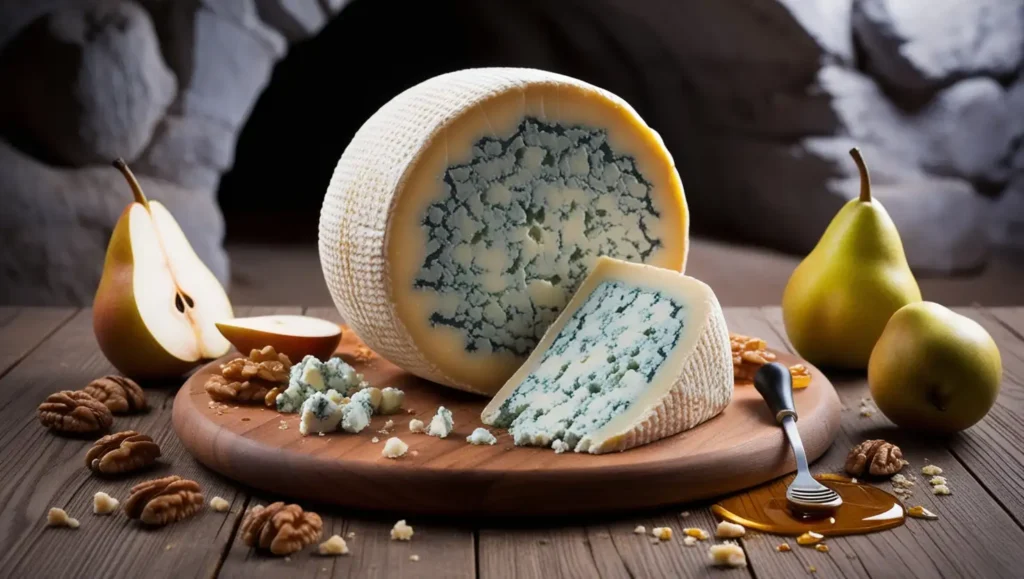
Roquefort is a famous French blue cheese made from sheep’s milk, known for its crumbly texture and bold, tangy flavour. It is characterized by blue-green veins of mould, which develop as the cheese ages in natural limestone caves in France, giving it a strong, salty, and slightly spicy taste.
Origin & History
Roquefort comes from Southern France and is one of the oldest known cheeses, dating back to Roman times. It is PDO-protected, meaning it can only be produced in specific regions and aged in the Combalou caves of Roquefort-sur-Soulzon.
Milk Type & Production
Made from sheep’s milk, giving it a rich, creamy texture., Aged for at least 3 months in limestone caves, where the Penicillium roqueforti mold develops.
Uses of Roquefort Cheese
- Crumbled Over Salads – Adds a bold, tangy kick to fresh greens.
- Paired with Fruits & Nuts – Complements pears, figs, walnuts, and honey.
- Enjoyed with Bread & Wine – Best served with baguette and sweet wines like Sauternes.
30. Stilton
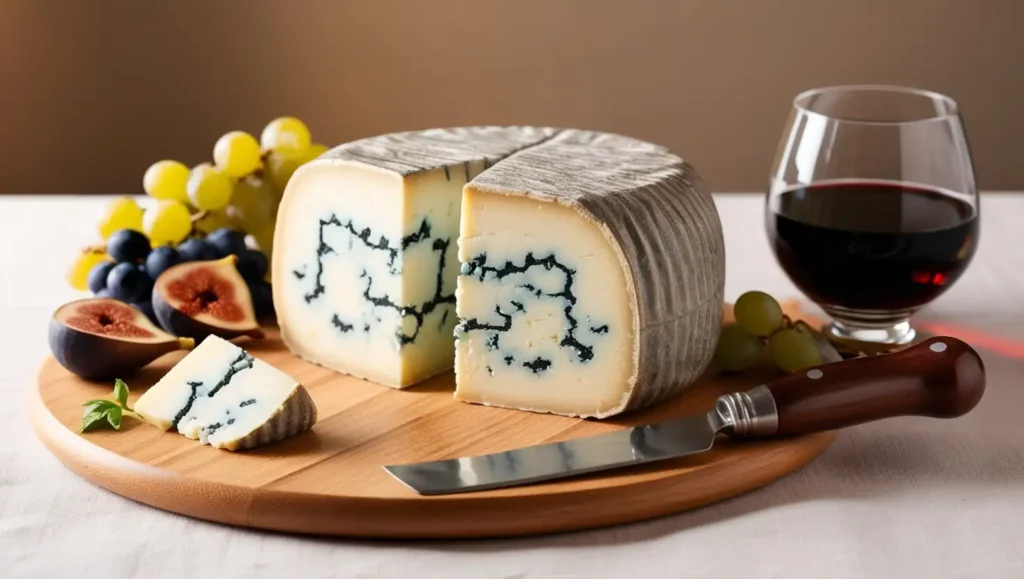
Stilton is a semi-hard English blue cheese, known for its crumbly texture and bold, tangy flavour. It features distinctive blue veins of mould running through its creamy interior, giving it a rich, slightly spicy taste. Stilton is aged for 9 to 12 weeks, allowing its complex flavours to fully develop.
Origin & History
Despite being named after the village of Stilton, the cheese is no longer made there. Instead, it is produced in Derbyshire, Leicestershire, and Nottinghamshire, following strict PDO regulations to ensure authenticity.
Milk Type & Production
Made from cow’s milk, giving it a creamy yet crumbly texture. Aged for 9-12 weeks, developing its distinct tangy and spicy notes.
Uses of Stilton Cheese
- Crumbled Over Salads – Adds a bold, tangy flavour to fresh greens.
- Melted into Sauces – Enhances steaks, pasta, and risottos.
- Served on Cheese Boards – Pairs well with fruits, nuts, and crackers.
- Enjoyed with Wine – Best paired with Port, Sherry, or Dessert Wines.
31. Bleu de Bresse

Bleu de Bresse is a semi-soft French blue cheese, known for its creamy texture and delicate blue veins. It has a mild, slightly tangy flavour with buttery notes, making it an excellent choice for those who enjoy subtle blue cheeses. Aged for at least four weeks, it develops a smooth, spreadable consistency and a gentle mushroom aroma.
Origin & History
Bleu de Bresse comes from the Bresse region in eastern France, an area known for its high-quality dairy products. It was created in the 1950s as France’s answer to Italian Gorgonzola, offering a smoother, milder alternative to stronger blue cheeses.
Milk Type & Production
Made from cow’s milk, giving it a buttery, creme
my texture. Aged for at least four weeks, developing delicate blue veins and mild tanginess.
Uses of Bleu de Bresse Cheese
- On Cheese Boards – Pairs well with fruits, nuts, and artisanal bread.
- Crumbled Over Salads – Adds a creamy contrast to fresh greens and sweet fruits.
- Melted into Dishes – Enhances quiches, sauces, and stuffed meats with a rich, savoury note.
Storage Tips
- Store in a cool, dark place with good air circulation or in the refrigerator.
- Wrap in greaseproof paper or aluminium foil to prevent drying out.
- Keep away from strong-smelling foods, as it absorb odours easily.
Conclusion
Cheese is a beloved and diverse food enjoyed worldwide, with each variety offering unique flavours, textures, and culinary applications. From creamy fresh cheeses to bold blue cheeses and aged hard cheeses, there is a type to suit every palate and recipe. Whether you’re grating Parmesan over pasta, melting Gouda in a sandwich, or savouring the tangy bite of Roquefort, cheese adds depth and richness to countless dishes. Exploring different cheeses allows you to experience the vast world of flavours, making every meal more enjoyable and indulgent.
Also Read:
This article was written by Saswata Banerjee, the creator of Food and Beverage Service Knowledge, based on 8+ years of experience in the hospitality industry.


